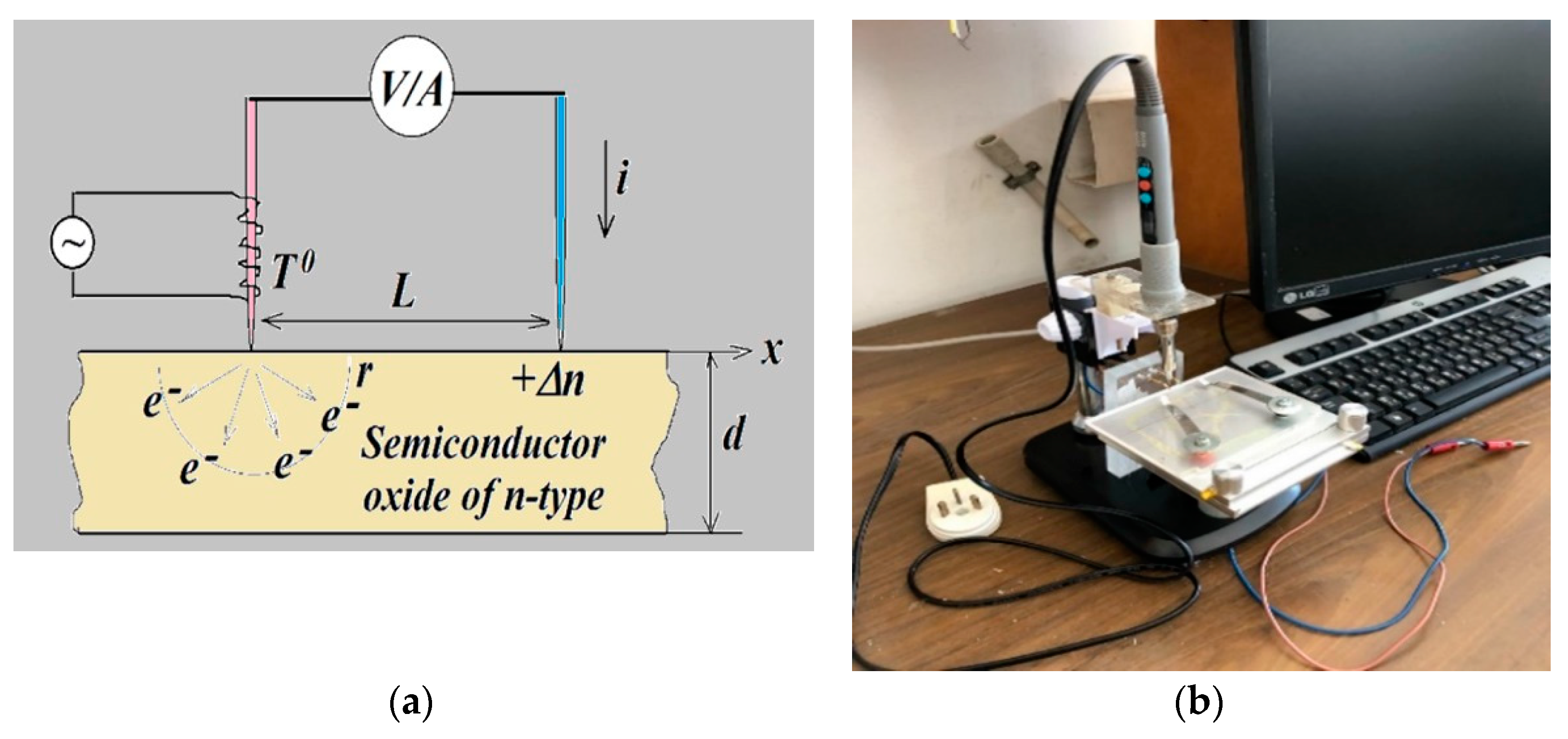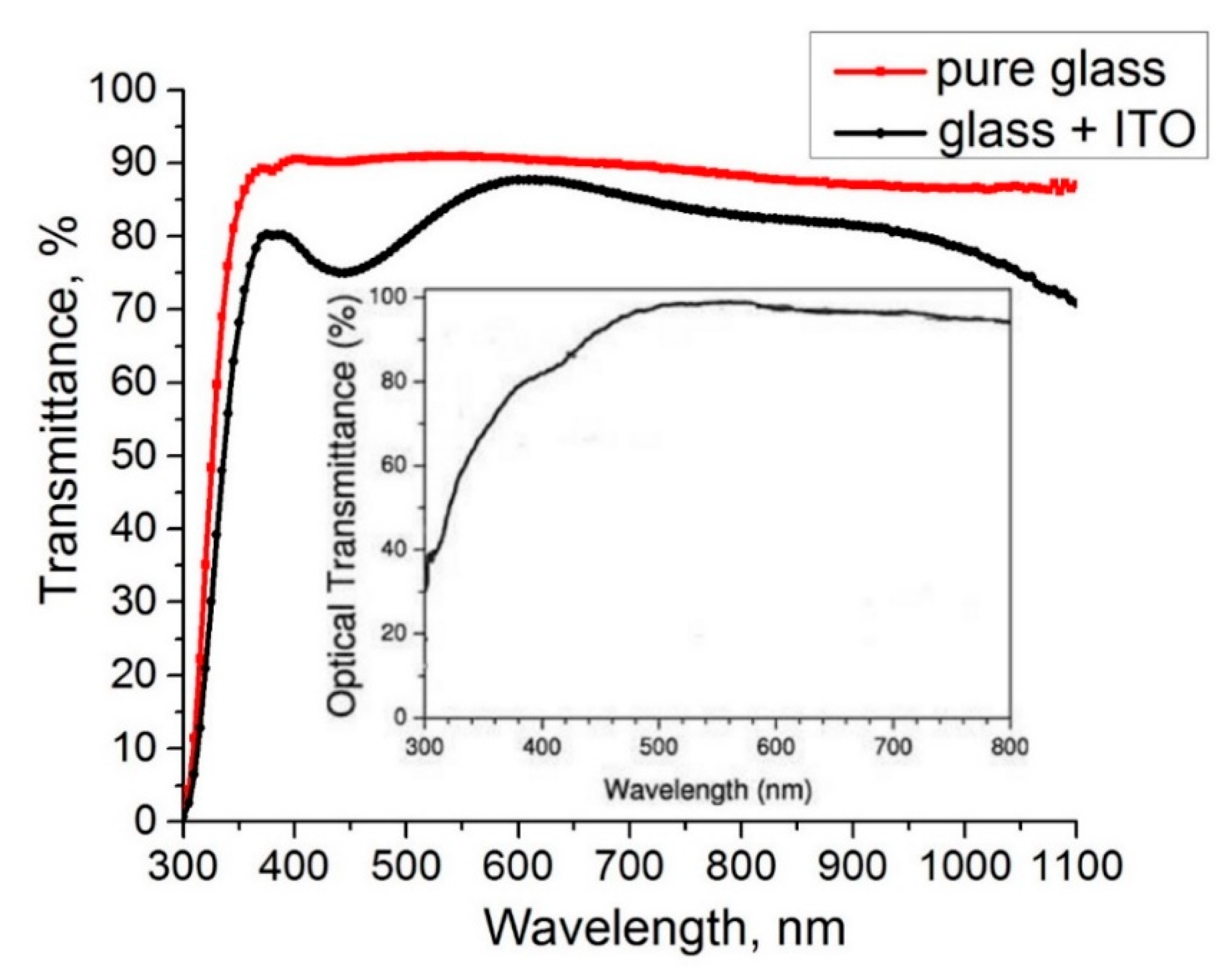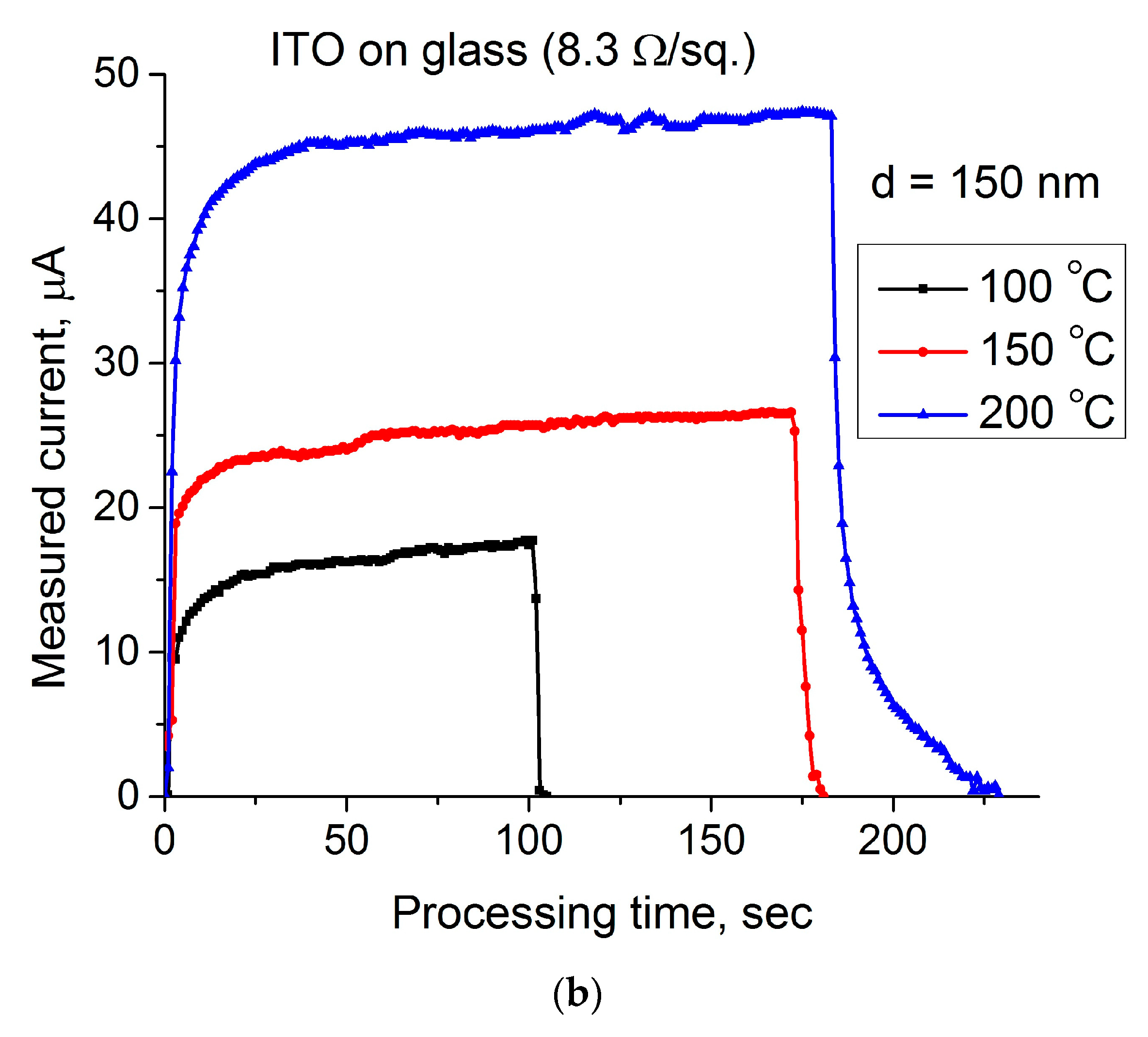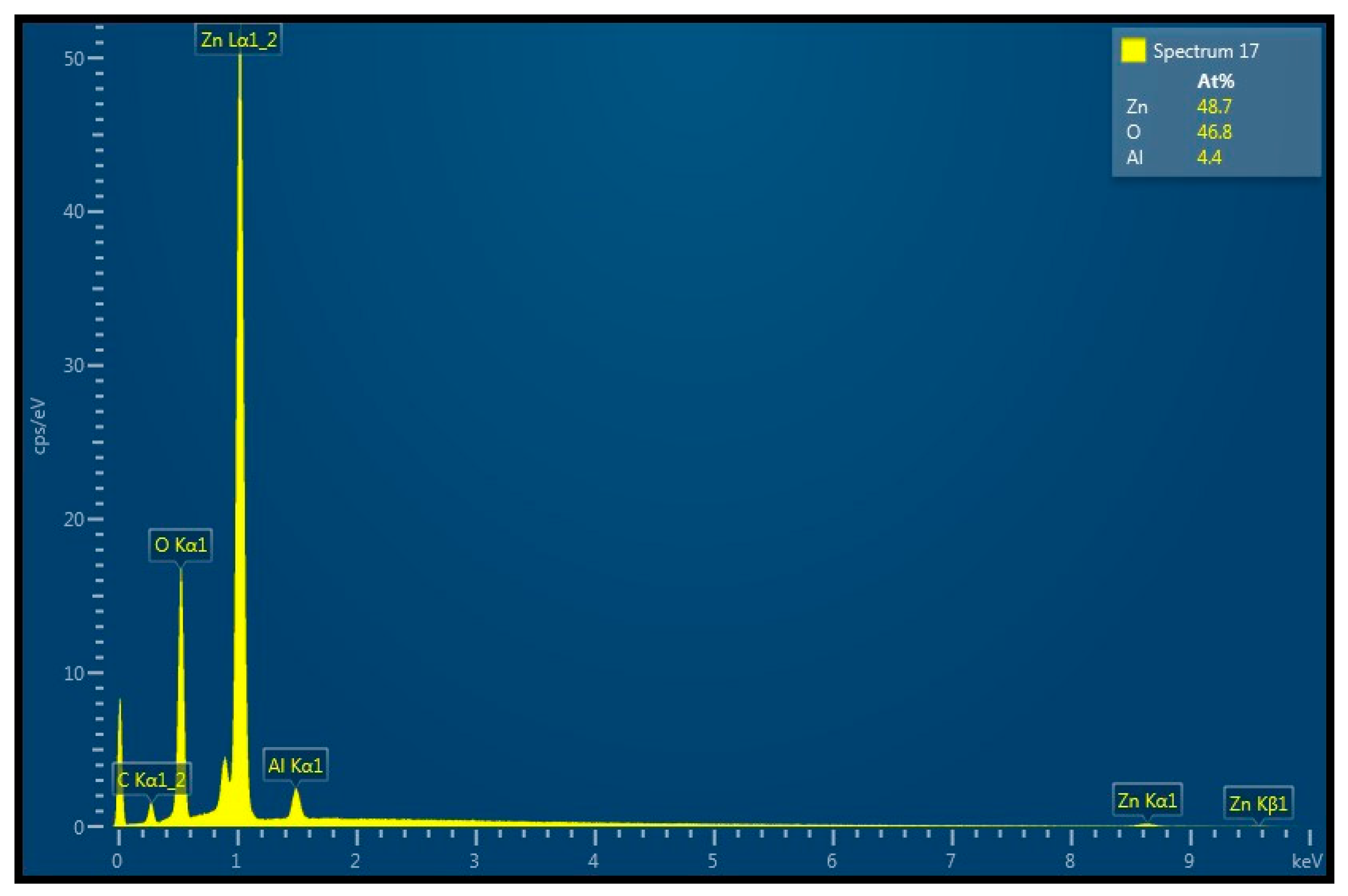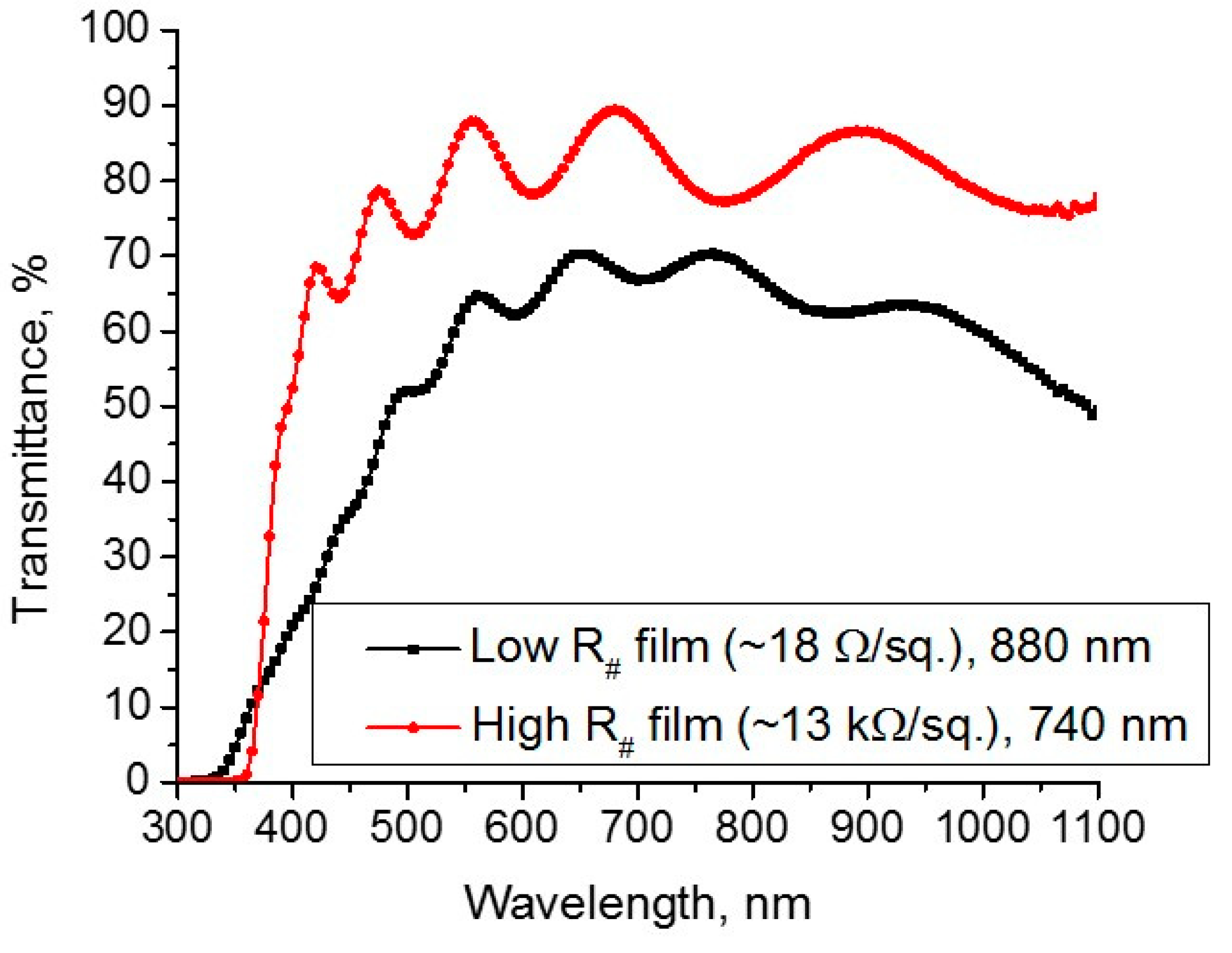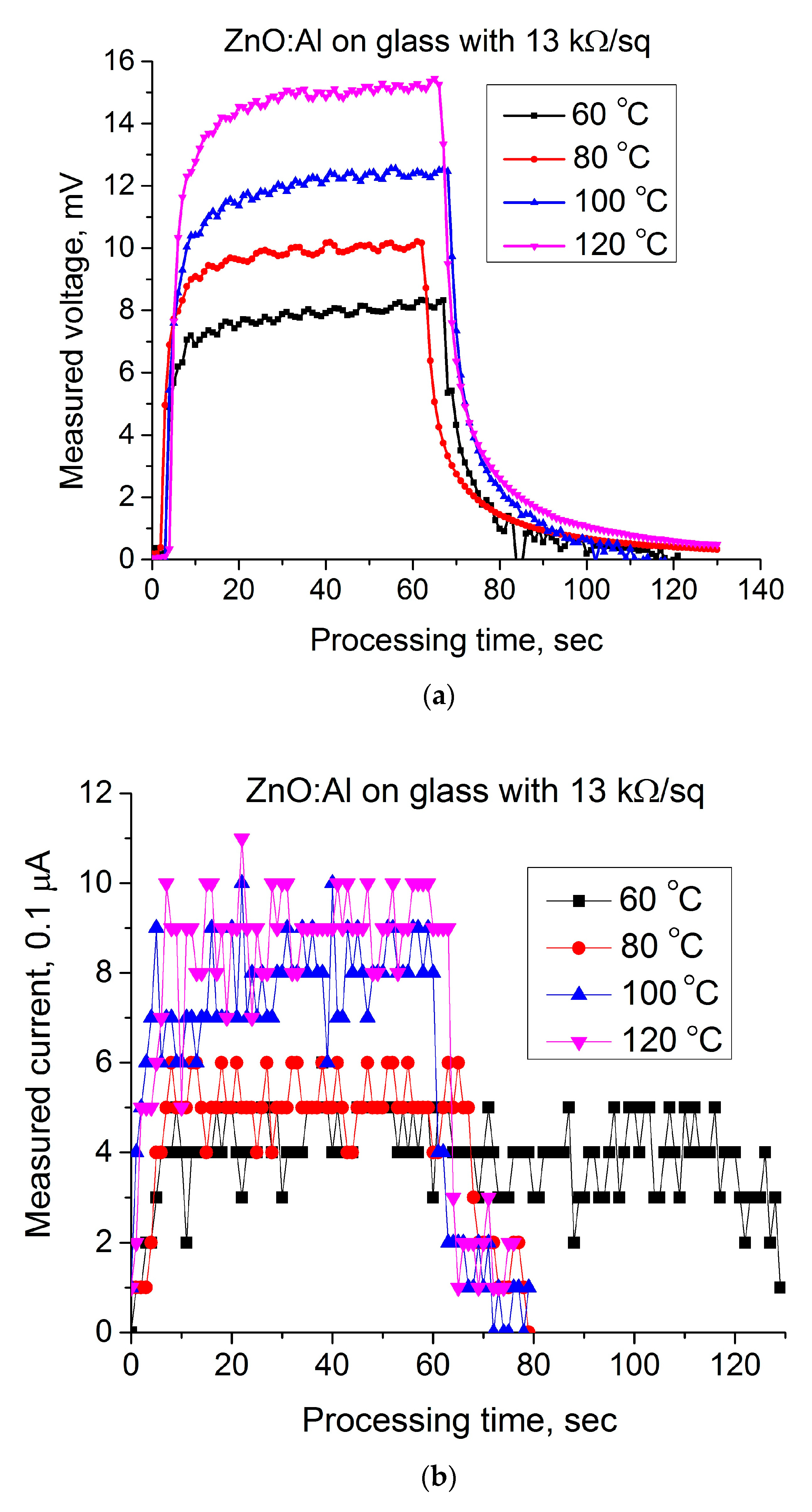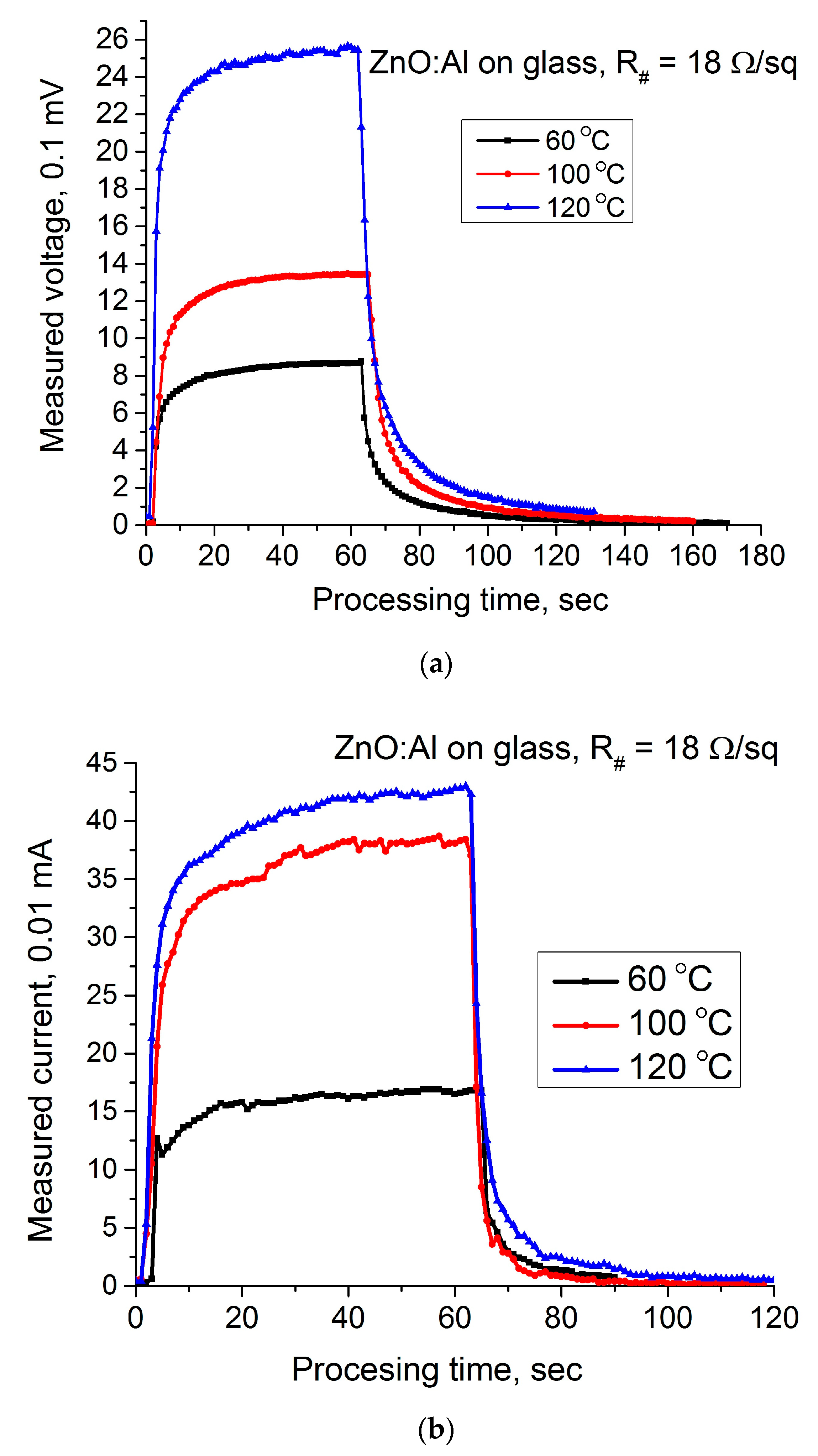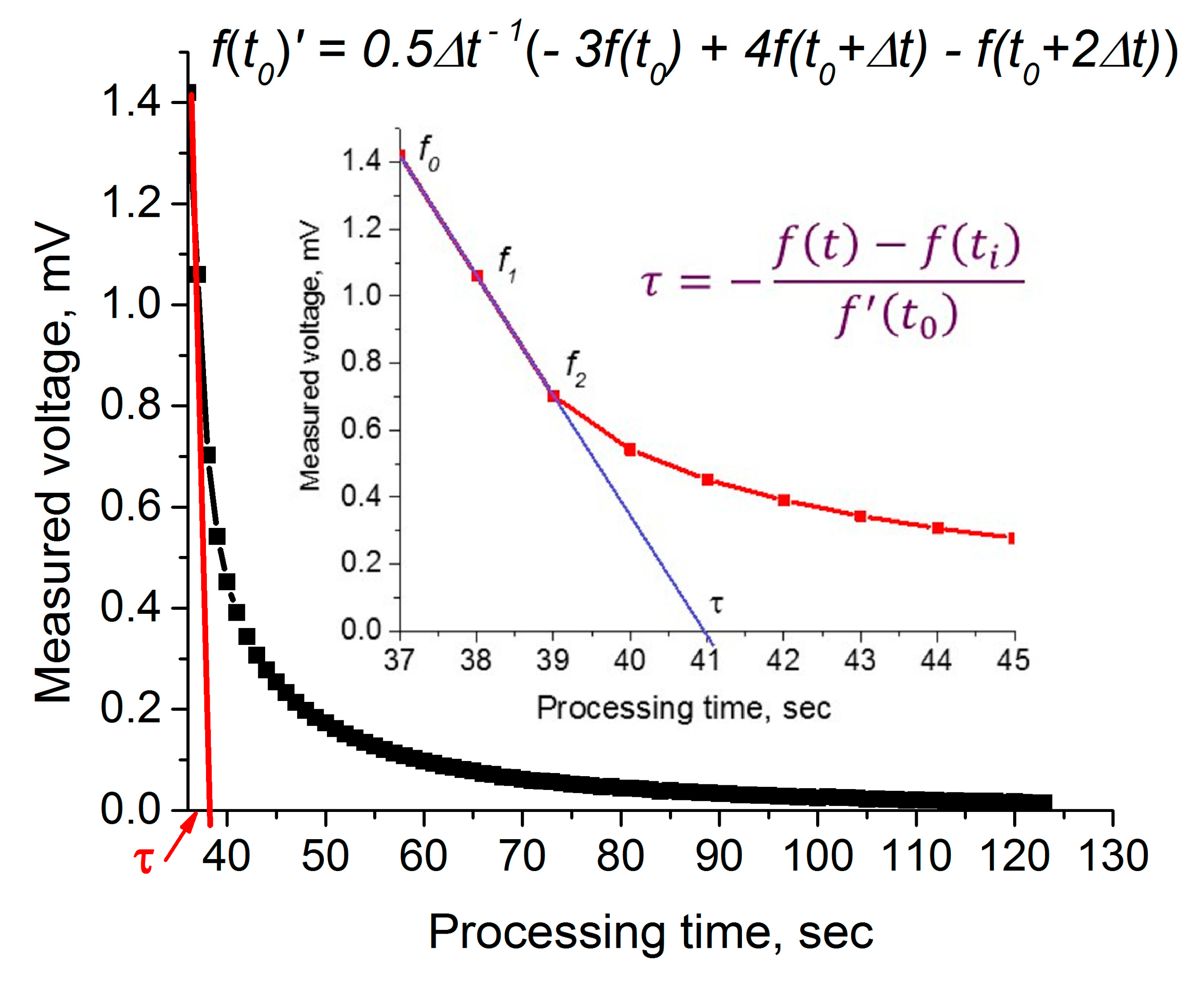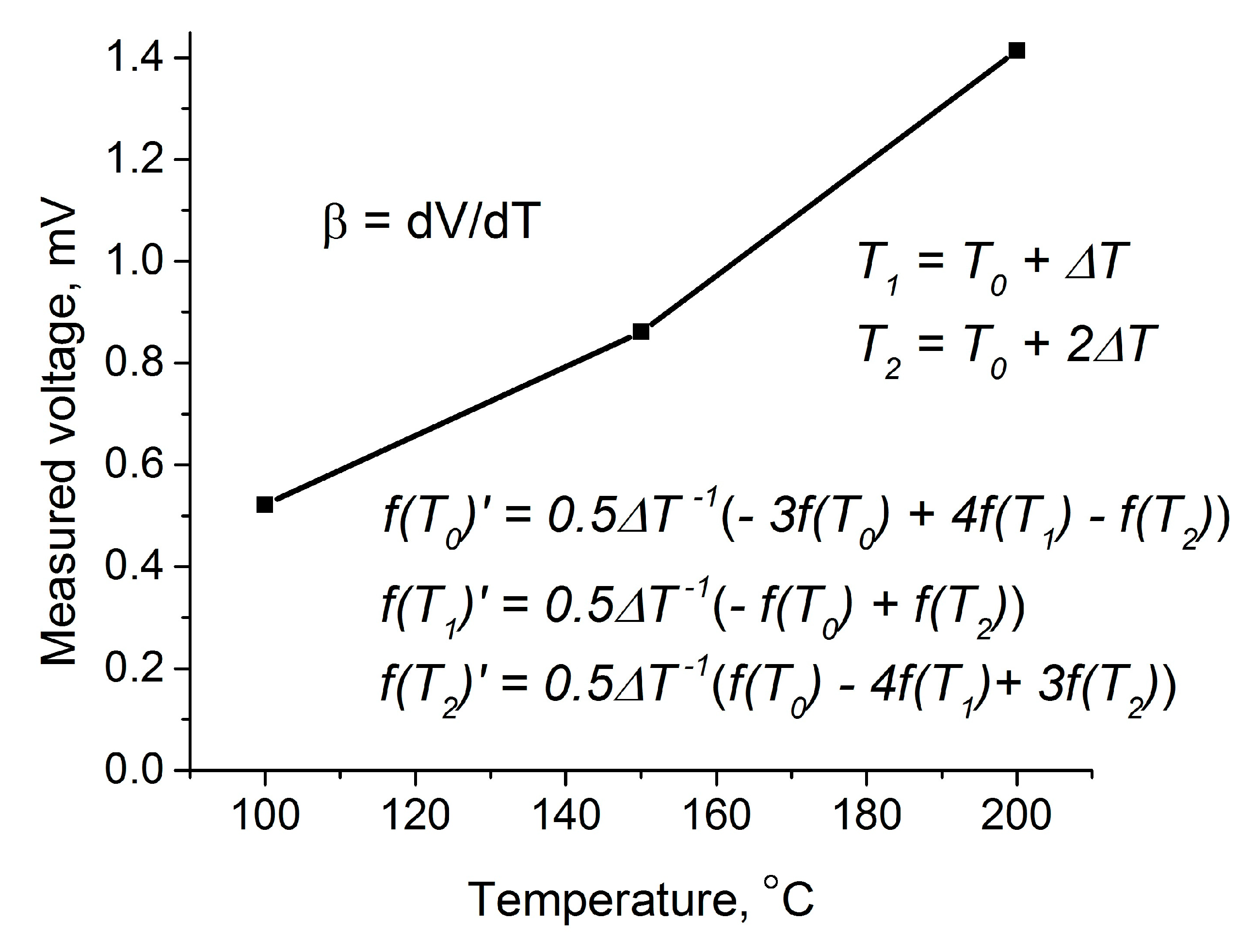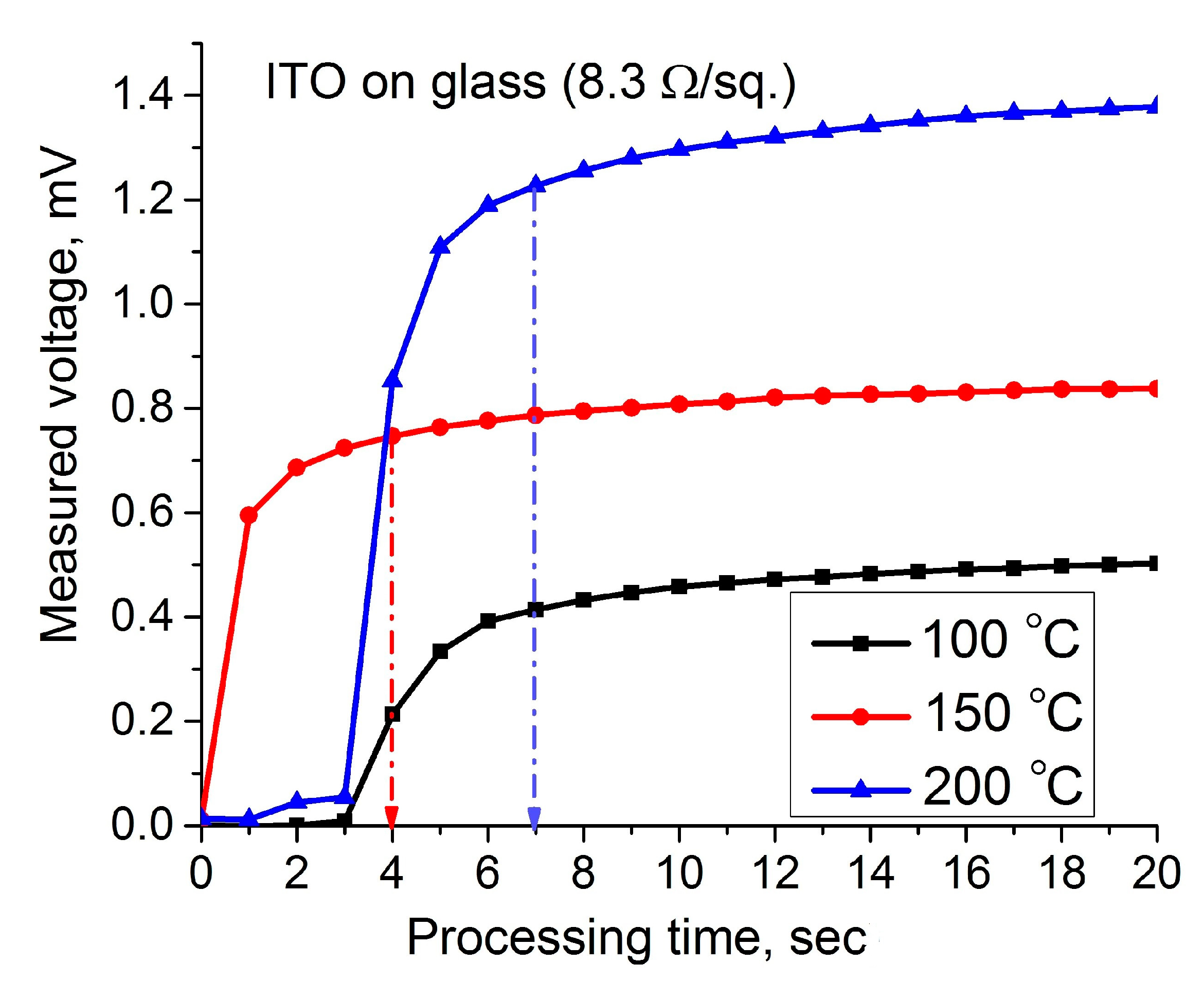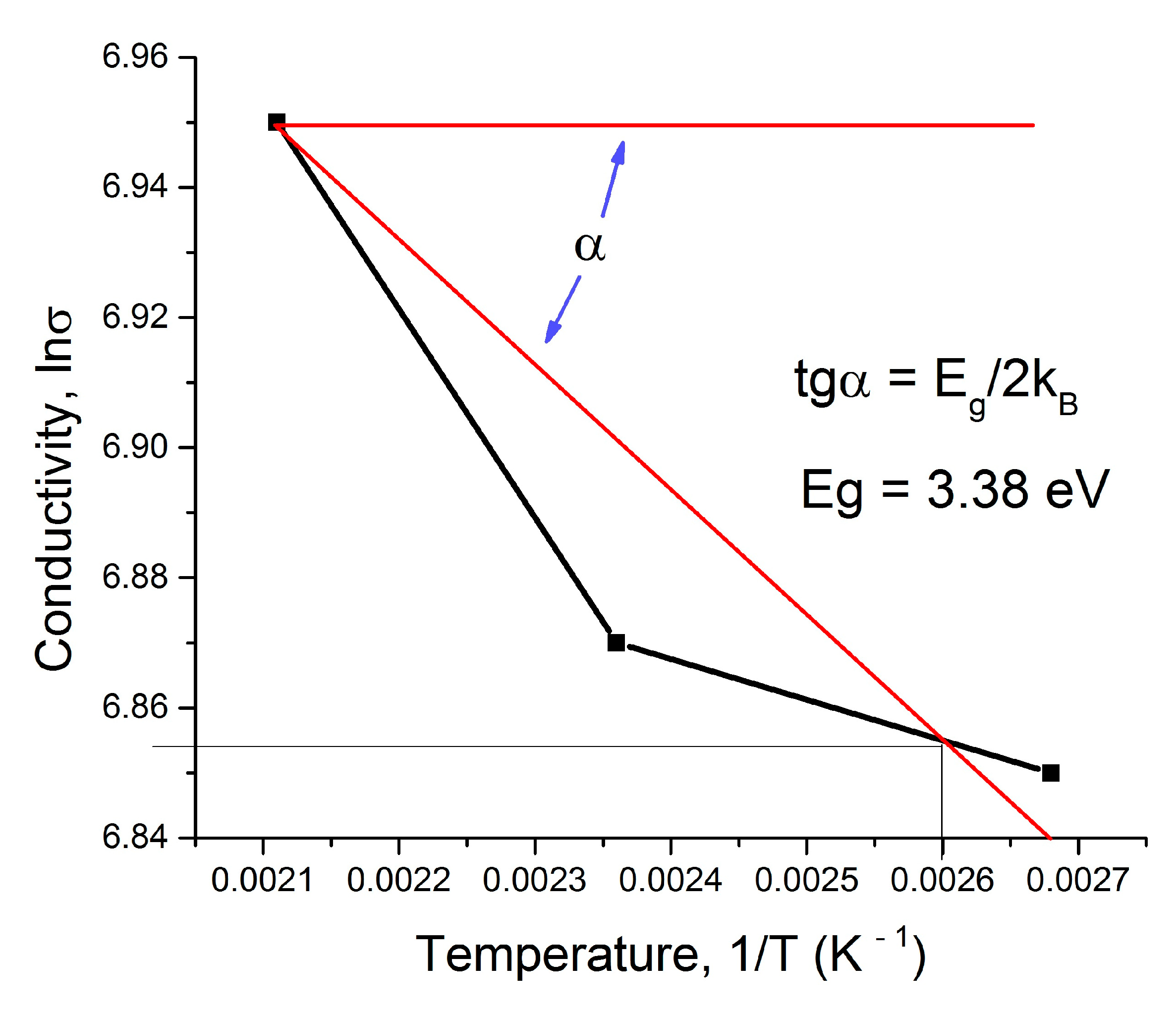2.1. Experimental Details
Two types of transparent conductive coatings were investigated: the commercial ITO-coated glass slides with dimensions 25 × 75 mm
2 and thickness of 1 mm of “Nanocs” and the glass slides of the same dimensions coated by thin ZnO films doped by Al with various concentrations. Sheet resistance and transmittance in the visible range of commercial ITO thin films are dependent on the film thickness. Usually, these films have a thickness of 15–300 nm, the sheet resistance of 5–100 Ω/sq, and the transmittance is over 85% [
16]. The optical properties of the films were measured using the spectrophotometer UV-VIS “BioMate 3S”. The films’ topography was studied using the metallurgical microscope Hirox RH-2000. The surface resistivity was measured by the standard four-point method using the Macor-probe of MDC. Rough approximate estimation of the films’ thickness was carried out by weighing the substrates before and after deposition by using the analytical balance ASB-220-C2. In addition, the thickness of the films can be determined on the basis of the interference fringes of the measured transmittance characteristics. This approach was applied to estimate the thickness of a commercial ITO film. The dynamic hot-probe method was used for characterization of the type, concentration, and mobility of the major charge carriers in commercial ITO coatings and grown AZO thin films.
Figure 1 represents the principal measurement scheme (a) and the laboratory home-made setup for dynamic hot-probe measurements (b). To provide measurements, we applied the Digital Multimeter 34405A of Agilent and the software “Keysight BenchVue” providing the real-time measurement and the recording of measured signals. The measurement duration was chosen from 30 to 90 s in order to avoid heating of the second (cold) electrode. It is known that the temperature of the cold electrode does not exceed room temperature by more than 20 °C during the specified time period when temperatures of the hot electrode do not exceed 300 °C [
14].
The principle of operation of this technique is that the heated majority of charge carriers, electrons or holes, have a higher velocity of movement than the cold ones. As soon as we begin to heat one of two electrodes, joining the surface of the semiconductor, the major charge carriers run away from it. As a result, a potential difference arises between the hot and cold electrodes, the sign of which is determined by the type of major charge carriers. If the heated electrode is connected to the positive terminal of the measuring voltmeter, electronic conductivity will show a positive voltage, and a hole-type material will show a negative voltage. To short-circuit the hot and the cold electrodes with an ammeter, a current will begin to flow through it. The sign of the current is defined by the type of the major charge carriers. The bandgap of transparent conductive oxides is large; therefore, the growth in the concentration of intrinsic charge carriers due to the heating of the hot electrode will be vanishingly small. Therefore, only thermal running away of the heated charge carriers should be taken into account through the evaluation process. Analysis of the measured dynamic characteristics of voltage and current dependences on the temperature conditions allows us to determine the recombination rate, the concentration, and the mobility of majority carriers.
ZnO thin films alloyed with Al were deposited simultaneously by the magnetron co-sputtering using a VST service RF-DC sputtering system, model TESF-842, equipped with a turbomolecular pump enabling an ultimate pressure lower than 5·10
−7 Torr [
17]. The system includes three magnetrons of 2 inches in diameter and enables the simultaneous co-sputtering process using a 13.56 MHz, 300 W RF generator and two DC supplies of 1000 W each. All thin films were deposited at argon atmosphere with the pressure of 3–5 mTorr. Deposition duration was 30 min always. The RF power was supplied to the ZnO target, and the DC power was applied to the Al target. These thin films were grown at room temperature, and they were annealed after deposition in vacuum at 300, 400, and 500 °C through one hour. The amount of Al in the ZnO matrix was controlled by the relation of power applied to the Al target. We tried to grow the ZnO thin films alloyed with approximately 2% weight of aluminum. Evaluation of the thin films composition was provided using Energy Dispersive Spectrometry (EDS) system—Oxford Instruments X-Max
N detector (Czech Republic) completed with the electronic microscope FEG-SEM Tescan Mira 3.
2.2. Theoretical Background
Let us consider once more
Figure 1a, the principal operation scheme of the hot-probe measurements. Charge carriers in semiconductors can be in two states: a state of static (thermodynamic) equilibrium and a non-equilibrium state, due to external influences that may be electric, magnetic, or temperature fields. The distribution of charged carriers on energy in the equilibrium state is defined by the Fermi–Dirac equation
where
EF is a Fermi energy,
T is the absolute temperature in Kelvins, and
kB is the Boltzmann constant. At the presence of external influences, the charge carriers system will be described by the non-equilibrium distribution function
f(
E) =
f(
p,r,t) dependent on energy (momentum,
p), coordinates (
r), and time (
t). This function,
f(
E), takes into account all possible mechanisms by which the distribution function may be changed. In real materials, all charge carriers experience collisions with other particles, impurities, phonons, etc. So, the function
f(
E) should take into account the scattering of charged carriers due to collisions when the function comes to another equilibrium state. If the external influence is finished, the function will return to the initial state. By this way, the distribution function behavior may be presented by three different parts: an excitation, defined by the value of influencing external field; a steady state with slow current processes; and a relaxation part with a return to the initial state.
All these parts may be described by the same general equation taking into account all external and internal processes. In general, the behavior of charged carriers, in particular electrons, can be described by the well-known Boltzmann Transport Equation (BTE), which in differential form looks as follows [
18,
19]:
where the first summand on the left side represents the function variation in time, the second represents the influences of external fields, and the third shows the coordinate variation. The right part of the equation takes into account different types of collisions affecting the motion of particles: scattering by ionized impurities, scattering by neutral impurities, scattering by dislocations, and scattering by grain barriers, which is very important for polycrystalline semiconductor thin films [
20]. The right side represents a scattering of the particles and, for simplicity, it may be presented using an electron relaxation time,
τ. In the case when there are not external fields and charge carriers, return from the excited state to the initial state occurs as follows (relaxation time approximation):
This value, τ, depends on the dominant scattering mechanisms and may be found from experimentally measured dynamic hot-probe characteristics.
To evaluate the recorded dynamic hot-probe characteristics, it is necessary to transform the BTE into an equation without external electrical and magnetic fields; it must take into account only the temperature gradient affecting the movement of charge carriers. Only an internal electric field arises with a directed flow of charge carriers. We also assume that the material being measured is isotropic and the charge carriers flux occurs in only one
x direction, where
x denotes the
r coordinate.
where
Eex is an external electrical field. According to Relation (4), the force related term in the full BTE (2) may be described as follows:
however, in the case of no external electrical field, this term will be vanished.
When the material is heated at a certain point on the surface, the charge carriers begin to move and, thus, they create a current and an electrical field in accordance with the following relationship [
21]:
where
j is the current density, σ is the conductivity of a material dependent on temperature, and β is the additional coefficient characterizing the thermo-electrical properties of the material. This coefficient represents the thermopower (the Seebeck coefficient) produced in the material under non-homogeneous heating due to charged carriers transport [
22]. Evidently, this movement occurs only up to reaching of steady state when the current reaches a suitable value
js (saturation state) and our material will come to the new dynamic steady state (excited state). In this state, the created electrical field is defined by the thermal non-equilibrium and moving charge carriers:
Equation (7) may be integrated on the distance
L, which takes the follows result:
Here, the conductivity of the sample may be described by the known formulae (the Drude equation):
where μ is the mobility of charge carriers and
n is its concentration. Both parameters, mobility and concentration of charge carriers, are functions of temperature. The mobility of charge carriers, μ, may be found using the well-known Einstein’s relation:
where
D is the diffusion coefficient of the major charge carriers,
kB is the Boltzmann’s constant, and
Te is an ambient temperature in K. Taking into account that the diffusion distance in our setup is equal to
, where τ is the measured relaxation time and substituting with Equation (10), we obtain:
On the other hand, the mobility of charge carriers characterizes the scattering processes through the average scattering relaxation time,
where
m* represents an effective mass of electrons. All scattering processes occur simultaneously; therefore, the mobility may be presented by two summands representing the lattice, μ
L, and impurity, μ
i, scattering:
The expressions for these parameters may be presented in following form [
23]:
where
Ni is the concentration of ionized impurities. Mobility may be found from recorded hot-probe characteristics using a numerical differentiation method, for example, using the known approximate three-point formula of Lagrange [
24]:
where a function
f represents the measured voltage,
t0 is the first time-point of the decreasing function, and Δ
t is the time-space between measured points. The thermopower may be found by the same way for suitable temperatures.
Combining Equations (8) and (9), we obtain an equation describing the behavior of the studied material under hot-probe measurement conditions.
When a heater comes in contact with the electrode, electrons run up into a semi-infinite space of a conductive matter. So, the current density will be related with the measured current,
is, according to the following equation:
where
r is a distance from the heated electrode (2π
r2 being the surface area of the hemisphere). The propagation of electrons in the space shaped in the form of a thin disc is limited by the disc thickness. Therefore, Equation (18) transforms into the following approximated relation at the distance of integration:
After substitution, Equation (17) transforms into the following final expression:
This equation, describing the system behavior in both excited and relaxed states, may be solved for the free charge carriers concentration:
Thus, one can calculate the concentration of charge carriers using the experimental data.
The concentration of free charge carriers depends significantly on the thickness of the studied thin film (see Equation (21)). Therefore, the method and accuracy of the thickness measurement will affect the results of our calculations. An error in determining the thickness leads to a deviation in the value of the concentration of charge carriers. Moreover, it is easy to show that the experimental error in determining the concentration of free charge carriers will always be less than the experimental error in measuring the thickness:
Therefore, the thickness becomes a decisive factor in determining the accuracy of the thin film parameters extracted from the hot-probe characteristics.
A real experiment is a process driven by both variable controlled parameters and random variables that influence the expected results. In the case of dynamic hot-probe measurement, these casual random values can represent a small deviation of the temperature of the heated electrode from the specified one, a change in the contact of this electrode with the sample being measured, etc. Therefore, in order to reduce the influence of various random parameters on the shape of the recorded hot-probe characteristic, it is desirable to carry out several measurements under the same conditions. Recorded characteristics in tabular form should be averaged to use in the following calculations. Obviously, the measurement accuracy increases with the number of measurements. Usually, in order to achieve required process accuracy, it is sufficient to carry out three different measurements at the same temperature and process duration in different places of the studied thin film.
